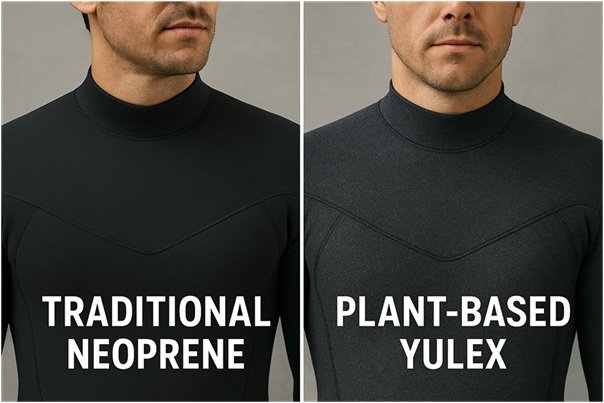For years, the wetsuit industry has relied heavily on traditional neoprene, a petroleum-based material known for its durability and insulation. But as environmental concerns grow, wetsuit manufacturers are rethinking how these essential products are made. The push toward sustainability is no longer a niche idea—it has become a central focus for both established companies and emerging brands.
The Environmental Challenge of Traditional Neoprene
Neoprene, the standard material used in wetsuits for decades, has significant environmental drawbacks. It is derived from petroleum, a nonrenewable resource, and its production involves high energy use and carbon emissions. Beyond manufacturing, disposal is another concern: neoprene is not biodegradable and can remain in landfills for centuries.
As a result, pressure from consumers, athletes, and environmental organizations has driven companies to search for greener alternatives. This demand has sparked a wave of innovation that is reshaping the wetsuit market.
Limestone-Based Neoprene: A First Step Forward
One of the earliest eco-friendly innovations was the adoption of limestone-based neoprene. Instead of crude oil, manufacturers extract calcium carbonate from limestone and convert it into chloroprene rubber. While this still involves mining and energy consumption, the carbon footprint is lower compared to petroleum neoprene. Many brands embraced this option as a transitional step toward sustainability.
Plant-Based Alternatives: The Rise of Yulex
A more revolutionary change has come with plant-based materials, especially Yulex. Derived from natural rubber harvested from sustainable Hevea trees, Yulex offers performance comparable to neoprene but with a far smaller environmental impact. The production process emits fewer greenhouse gases, and responsibly managed rubber plantations can support biodiversity.
Leading surf and dive companies have begun offering wetsuits made entirely from Yulex blends. Although slightly more expensive, these products are gaining traction as consumers become more eco-conscious.
Recycled Materials: Closing the Loop
Another trend is the use of recycled inputs to reduce waste. Some wetsuits now incorporate recycled polyester or nylon for the fabric linings. These materials are often made from post-consumer waste such as plastic bottles or discarded fishing nets. By reusing resources that would otherwise pollute the environment, manufacturers are contributing to a circular economy.
Additionally, offcuts from the wetsuit production process are increasingly being recycled back into new wetsuits or repurposed for other products like footwear or accessories. This reduces waste at the factory level while extending the life of raw materials.
Water-Based Adhesives and Dope-Dyeing
Beyond the core material, other parts of the wetsuit-making process have also been reengineered. Traditional wetsuit adhesives often contained solvents that emitted volatile organic compounds (VOCs). Many companies have switched to water-based adhesives, which are safer for workers and reduce environmental harm.
Similarly, innovations in dyeing fabrics—such as dope-dyeing, where color is added at the polymer stage rather than afterward—save water, reduce chemical use, and cut down on energy consumption. These changes might seem small individually, but they add up to a significant reduction in environmental impact.
Balancing Performance with Sustainability
The challenge for manufacturers lies in ensuring that eco-friendly materials perform as well as—or better than—traditional neoprene. Surfers, divers, and swimmers depend on wetsuits for warmth, flexibility, and durability in demanding conditions. Early plant-based or recycled materials sometimes fell short in terms of stretch or longevity, but ongoing research and testing have improved performance dramatically.
Professional athletes and outdoor enthusiasts now endorse sustainable wetsuits, proving that eco-conscious choices can meet high-performance needs. This growing acceptance is encouraging more brands to invest in innovation.
The Role of Consumer Demand
Ultimately, innovation in wetsuit materials is fueled by consumer expectations. Shoppers today want products that align with their values, and sustainability ranks high on that list. Companies that fail to adapt risk falling behind, while those that embrace change can strengthen brand loyalty and appeal to a growing eco-aware audience.
As with many industries, transparency is key. Brands that openly share details about their sourcing, materials, and carbon footprint often gain a competitive edge. Certifications such as Fair Trade, FSC (Forest Stewardship Council), or Bluesign further reassure customers that products meet strict environmental and ethical standards.
Looking Ahead
The wetsuit industry is moving in a clear direction: toward a future where high performance and sustainability go hand in hand. Plant-based rubbers, recycled fabrics, cleaner adhesives, and innovative dyeing techniques are all steps toward reducing environmental impact.
What was once a small experiment by a few niche brands has become a mainstream movement. As technology improves and costs come down, eco-friendly wetsuits will likely become the new standard rather than the exception. For athletes and ocean lovers, this means being able to enjoy the water while protecting the very environment that makes those adventures possible.




